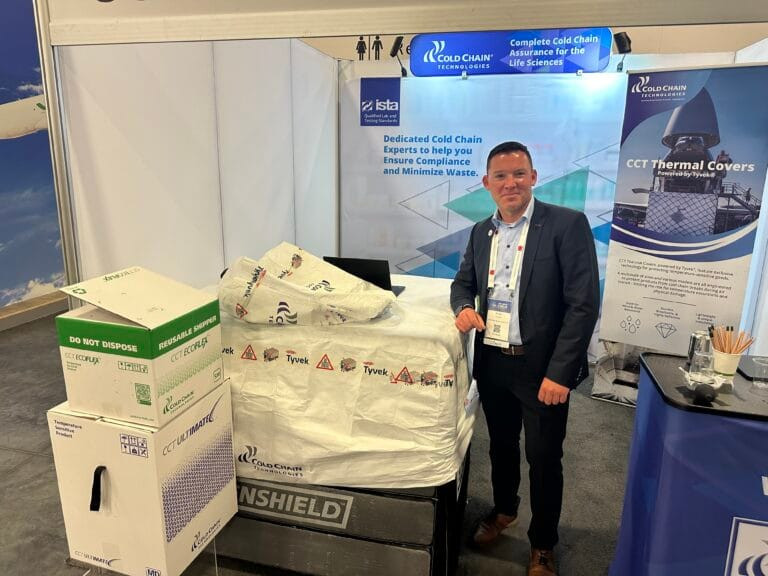Cold chain logistics, in particular, stands out as one of the most time-sensitive and care-intensive cargo segments. Innovative approaches in technology and efficiency are vital to its growth —not just for companies but also for the customers they serve. As such, sustainability and emerging technologies, including AI, are presenting both opportunities and challenges, particularly in security and operational adjustments.
“Maintaining customer focus requires continuous evaluation of our portfolio to ensure it aligns with market needs. For example, the trend toward sustainable packaging – while the packaging industry isn’t inherently seen as sustainable, we actively gather customer feedback to drive improvements,” Kristof De Smedt, Global Business Unit Director, Cargo Covers at Cold Chain Technologies (CCT), said.
“Likewise, We’ve launched discussions with stakeholders across the supply chain to integrate cold chain packaging solutions into digital booking platforms.
“The goal is to create a seamless, collaborative digital ecosystem where customers can include packaging solutions directly through an online portal. This shift to a unified digital approach reflects the future of communication and operational efficiency in the industry.”
Preparing the right packaging
Having the correct packaging is essential. Cold Chain Technologies has been working closely with customers to develop tailored solutions based on their specific shipping profiles.
For example, the requirements for different types of medications vary significantly, especially with the advancements in cell and gene therapies, which require extremely low temperatures—down to -120°C or even -200°C.
Alongside serving the needs of customers, packaging must be increasingly sustainable, with regulations, such as the European Green Deal, requiring a percentage of packaging to be recyclable by 2030.
“The pace of adoption varies globally—in the US, Latin America, and other regions, the regulatory landscape is different. As a global player, we aim to stay ahead by focusing on innovation and providing solutions that meet or exceed standards, regardless of location,” De Smedt outlined.
“We’re also developing new insulation materials, such as our cellulose-based “natural” insulation. This material can integrate into existing recycling streams, addressing one of the significant challenges in regions without established waste-management infrastructure. It’s all about creating smart solutions that align with local conditions.”
Cool chain concept
CCT is advancing a “one-stop-shop” concept with an expanded portfolio that emphasises sustainability, reuse solutions, and digitalisation. This is especially critical with the growing prevalence of cell and gene therapies, which demand advanced capabilities like enhanced track-and-trace systems. Handling these therapies introduces significant logistical complexities, dealing with time-critical materials.
Providing the right care and sensitivity to meet these varying requirements is a cornerstone of the product development process. Rather than creating generic solutions and offering them to clients, companies must engage with them to understand their pain points and develop customised solutions.
“We heard from pharma experts about the transformative potential of cell and gene solutions for previously untreatable conditions. While this presents new opportunities, it also increases the need for precise, just-in-time deliveries—a focus area where CCT is heavily investing in digital solutions,” De Smedt explained.
“Digital and technical customer solutions are an intrinsic part of daily operations. To your point, we’ve been actively preaching and exemplifying the importance of collaboration within the supply chain at recent air cargo events. Collaboration between stakeholders—whether they’re pharmaceutical clients, freight forwarders, or airlines—is key.”
Progress through partnerships
In a globalised world, tools that enable collaboration are becoming increasingly critical. Success is directly tied to the strength of every stakeholder, as the supply chain is only as strong as its weakest link.
For collaboration to work, it must be a win-win situation. Internally, companies rigorously monitor partnerships to ensure mutual benefit. Profitability remains a key factor, but so does creating value through collaboration.
“No single company can explore every potential solution, so collaboration becomes crucial. If one partner focuses on a specific area while another works on something different, both can share their knowledge and experiences. This allows you to learn what works and apply the right tools to your operations without duplicating efforts,” De Smedt stated.
By leveraging the strengths of all stakeholders, we can build not only a stronger company but also a more resilient and efficient supply chain for the industry as a whole.
“We see ourselves as more than just a packaging provider; we bring knowledge and expertise to the table. At the same time, we recognise the need for specialised knowledge from partners—whether they’re airlines, freight forwarders, or niche market experts in areas like cell and gene therapies. The sector is rapidly evolving, and we rely on collaboration to keep pace with the complexity they introduce.”





